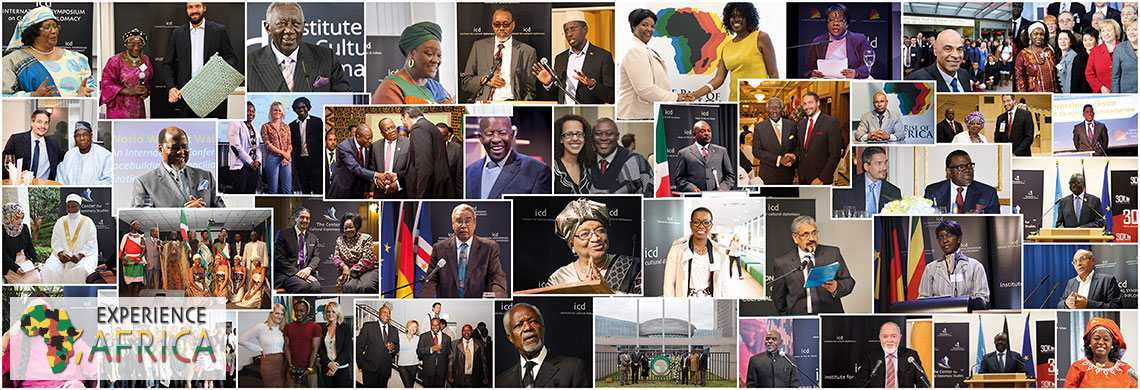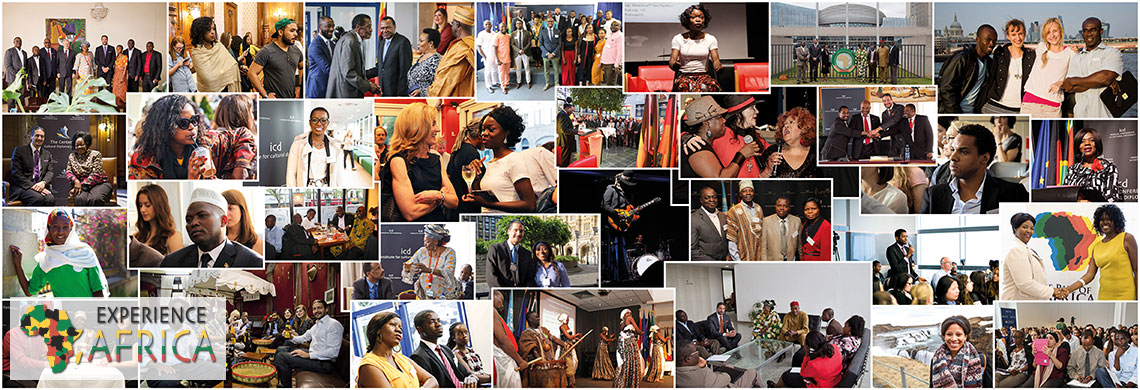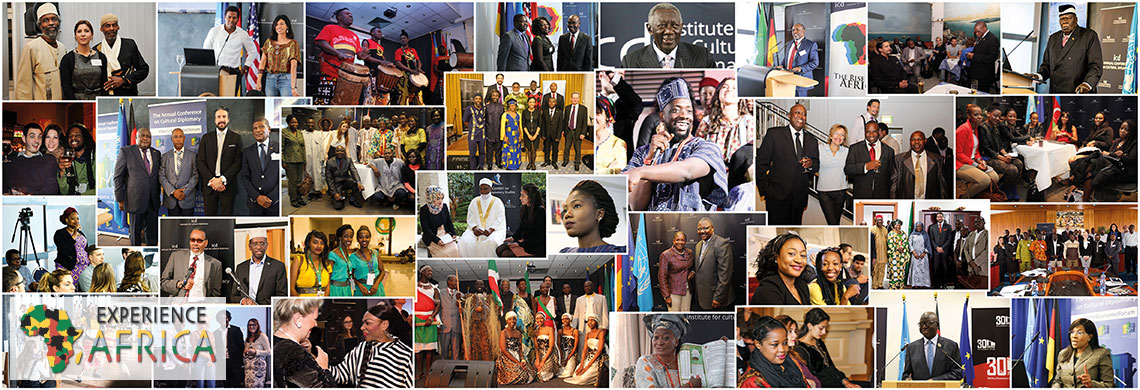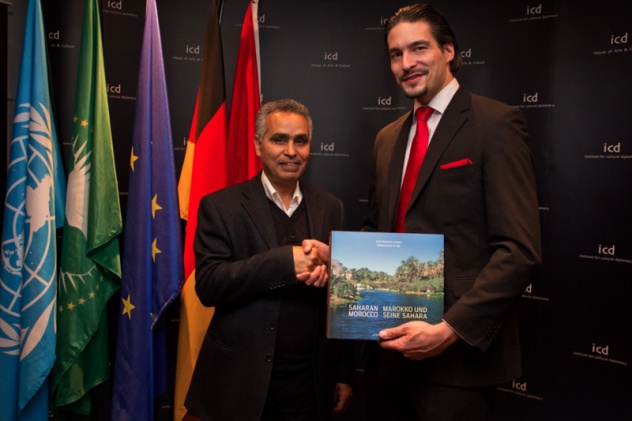"Stopover Moroccan Sahara" - Moroccan Cultural Evening & Book Presentation
Berlin
The Embassy of the Kingdom of Morocco hosted an Evening Reception and Book Presentation at the ICD House, on Thursday, March 14th, 2013. The event took place within the framework of the exhibition entitled “Stopover Moroccan Sahara,” and gathered diplomats, academics, young professionals, students, and members of the Moroccan community in Berlin.
Mark C. Donfried, Founder and Director of the Institute for Cultural Diplomacy, opened the evening with a few words of welcome and introduced the first speaker, Prof. Karim Anegay, Head of the Cactus Program at the Economic Promotion Office for Southern Morocco. Prof. Karim Anegay spoke briefly about his homeland, and the northern capital city of Rabat, where he spent most of his childhood. As a Moroccan from the North, Prof. Anegay mentioned that he has had the unique opportunity to discover Saharan roots and study the tribal history of the region, which remains an important element of Morocco's cultural and historical heritage.
Following his speech, Prof. Mohamed El Faiz, Professor at Cadi Ayyad University in Marrakech, gave a presentation of his book “Saharan Morocco,” which was published in 2008. Prof. El Faiz began his presentation with a quote from the famous 14th Century Arab historian, Ibn Khaldun, who said, “Culture is the beginning of Civilization.” The author emphasized that culture is the best and most effective means to bringing people together and developing dialogue between all societies and civilizations. He then spoke on the relationship between Morocco and the Western Sahara, and the historical developments that have taken place in the region since 1830.
In his presentation, Prof. El Faiz also mentioned two significant projects that emerged during the period of colonization. The first project was that of the Sahara Sea proposed by English engineer, Donald Mackenzie, and French Army officer, François Élie Roudaire, who wanted to create an inland Sahara Sea by flooding areas of the Sahara desert that were below sea level. The second undertaking was carried out by the ancient Romans and Greeks, who sought to Christianize the Western Sahara by spreading Western values and traditions among the people.
Although the two projects were unsuccessful, Prof. El Faiz stressed that these developments demonstrate how the Western Sahara has always encouraged new ideas, and the force of innovation remains strong in the region today. Prof. El Faiz subsequently spoke about the presence of oases, one of the key traits of the Saharan region today. These underground channels require enormous efforts and many hours of work, but have significantly contributed to exchange and commerce in the “golden capital” of trade. The Professor stated that such methods have slowly been transferred to other areas, and as a result, the people of the Sahara have become more urbanized. To conclude, Prof. El Faiz mentioned that since his book was published in 2008 and only focuses on northern Sahara, many questions remain to be answered, making this an extremely relevant and interesting subject of study.
The presentation was followed by a brief Question-and-Answer Session, which allowed the audience to interact directly with the author. When asked about the role of Cultural Diplomacy in promoting Morocco's cultural and historical heritage, Prof. El Faiz asserted that Cultural Diplomacy is about “knowing and getting to know other cultures.” As a result, concrete methods are required to promote Cultural Diplomacy other than financial means. Prof. El Faiz stressed that education has a key role to play in building bridges between Europe and the Arab World, and countering Islamophobia. In addition, he mentioned that the oases not only represent biodiversity, but also a lively heritage of humanity. The workers in the region have real human knowledge and experience, which only goes to show that the Sahara is not a dead space; it is the connecting link between Africa, the Arab World, and Europe, and hence a significant territory in terms of enhancing cultural exchange and reducing tensions. Finally, Prof. El Faiz stated that colonization remains a part of Moroccan history, and it is the understanding of this history which helps us better understand conflict in today's world.
Following the book reading, Prof. Karim Anegay took to the stage for the second time and spoke in greater depth about the Social and Economic Development of the Southern Provinces of Morocco. He focused on the provinces of Dakhla, Boujdour and Laayoune, which lie on a narrow peninsula along the Atlantic coast. Prof. Anegay talked about the huge potential for tourism in these areas, given their tropical climate, and the positive developments that have taken place in areas of employment, education heath and sanitation, and energy. In the final part of his lecture, Prof. Anegay mentioned the processes of decentralization and regionalization, stating that these processes are extensive, and thus require “extreme care, thought, technical knowledge, competency, and experience.” In his view, decentralization will improve development; however the Southern provinces have been left to the will of the Kingdom.
Final remarks were given by H.E. Amb. Omar Zniber, Ambassador of the Kingdom of Morocco to Germany. H.E. Amb. Zniber stated that the Embassy's aim is not only to promote Cultural Diplomacy, but to represent Morocco and its various aspects of its culture, whether it is food, fashion, festivals, history, or education. The Ambassador extended an invitation to the audience to visit the vibrant exhibition, “Stopover Saharan Morocco,” open at the Embassy until mid-April.
The evening concluded with a Reception featuring Moroccan instrumental music, cocktails, and scrumptious delicacies from the country, allowing everyone the opportunity to experience an evening of Cultural Diplomacy in action.




























